Hernia Exercises to Avoid – How to Prevent Hernia During Workout?

You wouldn’t wanna dislocate your body parts during workout. Hernia is a painful condition characterized by a lump or bulge which becomes more noticeable during standing, coughing or straining. Excessive straining puts alot of pressure on your organs leading to organ herniation. If you are facing this condition, you must avoid some exercises.
Below, we will discuss:
- What is hernia – types, symptoms, causes?
- How to prevent hernia during workout?
- Exercises YOU CAN DO with hernia
- And Hernia Exercises to Avoid?
Let’s start with,
Hernia Exercises to Avoid
If you have a hernia, there are certain types of exercises you should avoid to prevent worsening your condition and discomfort.
Always consult with a medical professional before starting any exercise routine if you have a hernia.
Here are some exercises to avoid:
Heavy Weightlifting
Activities that involve heavy lifting or straining, such as deadlifts, squats, and overhead presses, can put excessive pressure on the herniated area and lead to further complications.
Take a Closer Look: How To Squat Properly? Squat Tips And Benefits
High Impact Exercises
Exercises that involve jumping, bouncing, or sudden movements like running or jumping jacks can strain the hernia and increase discomfort.
Abdominal Crunches and Sit-ups
Traditional crunches and sit-ups can put significant stress on the abdominal muscles, potentially aggravating the hernia and causing pain.
Leg Raises
Exercises that involve lifting your legs while lying on your back can increase intra-abdominal pressure and potentially worsen the hernia.
Twisting Movements
Movements that involve twisting or rotating the torso, such as certain yoga poses or golf swings, can strain the herniated area and hinder the healing process.
Heavy Cardiovascular Activities
High-intensity cardio exercises like sprinting or intense cycling can lead to increased pressure in the abdominal region, potentially causing discomfort or aggravating the hernia.
CrossFit or Intense Functional Training
Workouts that combine heavy lifting, intense cardio, and varied movements may not be suitable for those with a hernia due to the risk of strain on the abdominal area.
Suggested Read: Calisthenics Vs Crossfit – What is Suitable For You?
Heavy Resistance Band Exercises
Activities involving strong resistance bands can put strain on the hernia and should be approached with caution.
Deep Twisting Yoga Poses
Yoga poses that involve deep twisting of the torso, especially if they target the abdominal area, should be avoided.
Pilates Hundred
This exercise involves lifting the head and shoulders off the ground while pumping the arms. These movements could strain the herniated area.
What is A Hernia?
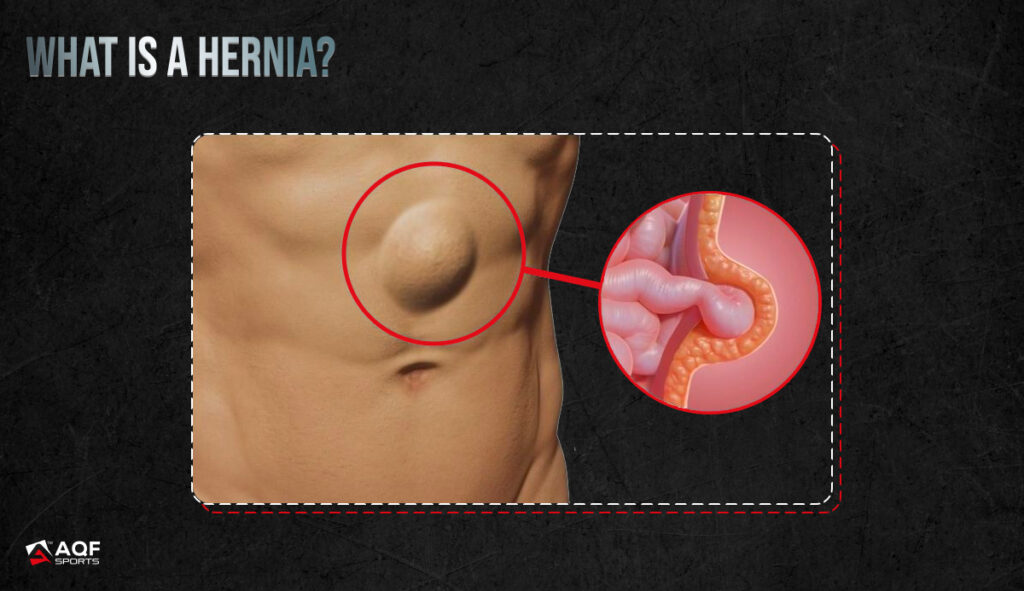
A hernia occurs when an organ or fatty tissue squeezes through a weak spot in the surrounding muscle or connective tissue. It creates a bulge or lump beneath the skin. Hernias occur in various parts of the body due to many factors.
Locating a Hernia
A visible or palpable bulge or lump which seems out of its actual place indicates a herniated location. Here are some common types of hernia:
Inguinal Hernia appears in the groin area and is more noticeable when standing up or straining.
Umbilical Hernia appears around the belly button and gets more noticeable during coughing or straining.
Femoral Hernia appears in the thigh or groin area and is more noticeable when standing.
Hiatal hernia affects the upper stomach and diaphragm.
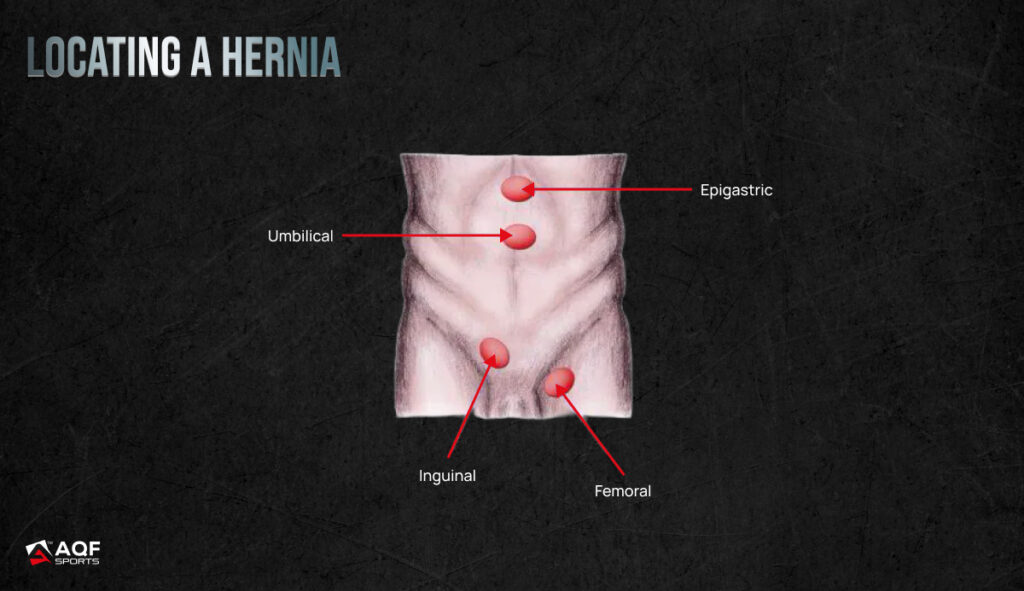
Common Symptoms of a Hernia
The most obvious symptom is a lump or bulge which appears during straining or standing.
You will feel pain or discomfort at the site of the bulge during physical activity, coughing, or lifting.
The herniated area will feel weak and heavy accompanied by a dull ache or burning sensation.
You may also experience pressure or fullness in the herniated abdomen or groin area.
Do You Know What Causes Hernia?
Hernias can be caused by a combination of factors, including:
Weak Muscles
Weakness in the surrounding muscle or connective tissue, often due to genetics or aging.
Strain and Pressure
Activities that increase intra-abdominal pressure, such as heavy lifting, chronic coughing, or constipation, can contribute to hernia development.
Congenital Factors
Some hernias are present at birth due to incomplete closure of abdominal wall structures.
Obesity
Being overweight or obese can put additional strain on the abdominal muscles, increasing the risk of hernias.
Pregnancy
Pregnancy and childbirth can contribute to weakened abdominal muscles and increase the risk of hernias.
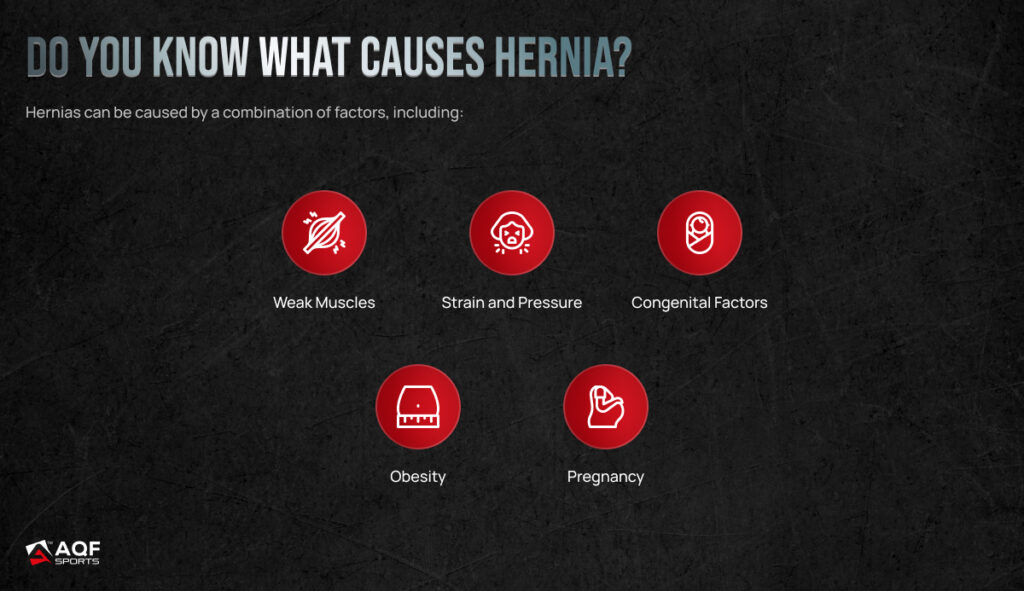
Does Heavy Lifting Cause Hernia?
There is no scientific evidence showing that heavy lifting alone contributes to herniation.
Heavy lifting, without following proper lifting techniques, can contribute to herniation. Lifting heavy objects while holding your breath strainins your organs and increases intra-abdominal pressure.
This pushes your organs or tissue through weak spots in the abdominal wall. However, it’s important to note that heavy lifting alone might not directly cause a hernia; rather, it can be a contributing factor in individuals with genetic disposition or other risk factors.
What Exercises YOU CAN DO with Hernia?
Always consult a medical professional before starting any exercise routine. They provide personalized recommendations based on your specific condition and needs.
Here are some exercises generally suitable for individuals with a hernia:
Walking/Light Jogging
Walking is a low-impact cardiovascular exercise that doesn’t put excessive strain on the abdominal area. It can help maintain overall fitness and promote healing.
Swimming
Swimming is another low-impact exercise that provides a full-body workout without putting stress on the herniated area. Just be cautious of strokes that involve significant twisting.
Stationary Cycling
Cycling on a stationary bike can be gentle on the abdomen and is a good option for cardiovascular fitness.
Modified Yoga
Gentle yoga poses that don’t involve deep twists or straining the abdominal muscles can be beneficial. Consult a yoga instructor who is experienced in working with individuals with hernias to create a safe routine.
Uncover More:
Pelvic Floor Exercises
Strengthening the pelvic floor muscles can provide support to the abdominal area. Kegel exercises are an example of pelvic floor exercises.
Upper Body Strength Training
Exercises that target the upper body, such as seated dumbbell presses, bicep curls, and shoulder raises, can be done without straining the hernia area.
Seated Leg Lifts
While lying on your back, lifting your legs one at a time while keeping your back supported can engage the core and legs without putting excessive pressure on the abdomen.
Core Stabilization Exercises
Gentle core exercises that focus on stability rather than flexion, such as planks on your elbows, can help without aggravating the hernia.
Gentle Stretching
Light stretching that doesn’t involve deep twists or intense stretching of the abdominal muscles can be beneficial for maintaining flexibility.
Breathing Exercises
Diaphragmatic breathing exercises can promote relaxation, help reduce stress, and indirectly support your core muscles.
How to Prevent Hernia During Heavy Lifting?
Follow safe lifting techniques and take appropriate preventative measures to avoid hernia during workout. Here are some useful ways to avoid hernias during strength training at gym:
Do The Valsalva Maneuver
When you lift weights, use the Valsalva maneuver to control your breathing and intraabdominal pressure.
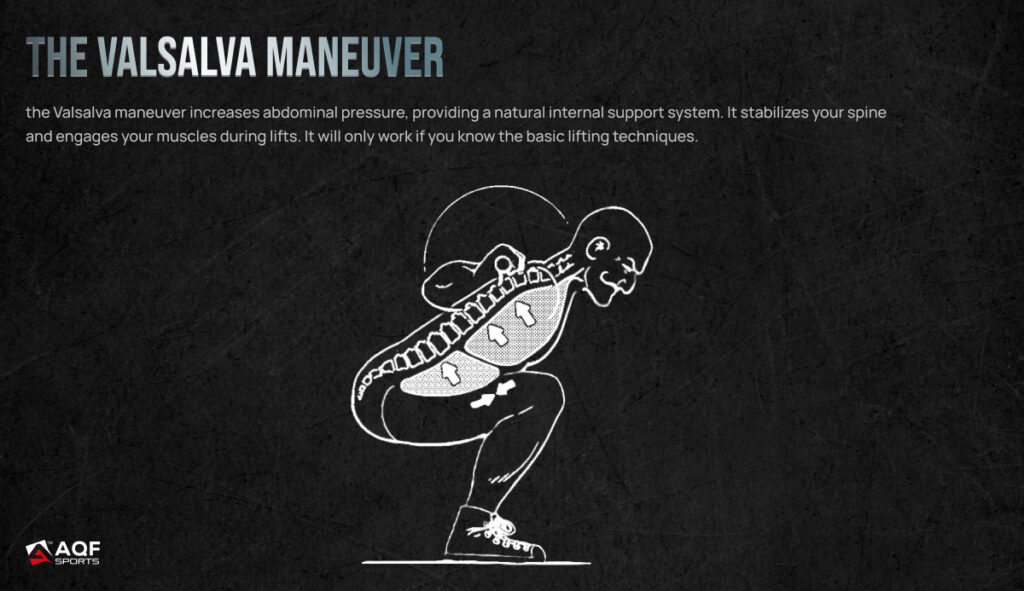
Here’s the science behind it: the Valsalva maneuver increases abdominal pressure, providing a natural internal support system. It stabilizes your spine and engages your muscles during lifts. It will only work if you know the basic lifting techniques.
How to Perform It?
Preparation:
Before you start lifting, take a deep breath in through your nose, filling your lungs as much as you can.
Hold Your Breath:
Keep your mouth and your glottis (the part in your throat that controls airflow) closed. Hold your breah to create intra-abdominal pressure.
Bear Down:
Just like doing a bowel movement, push your abdominal muscles out gently. This action increases the pressure inside your abdominal cavity and provides stability.
Lift:
Perform your lift and continue to hold your breath to maintain the intra-abdominal pressure. This increased pressure adds support to your spine and core muscles.
Release Breath:
Once you’ve completed the lift, exhale gently to release the held breath.
Resume Normal Breathing:
Resume normal breathing as you recover between sets or after the exertion phase.
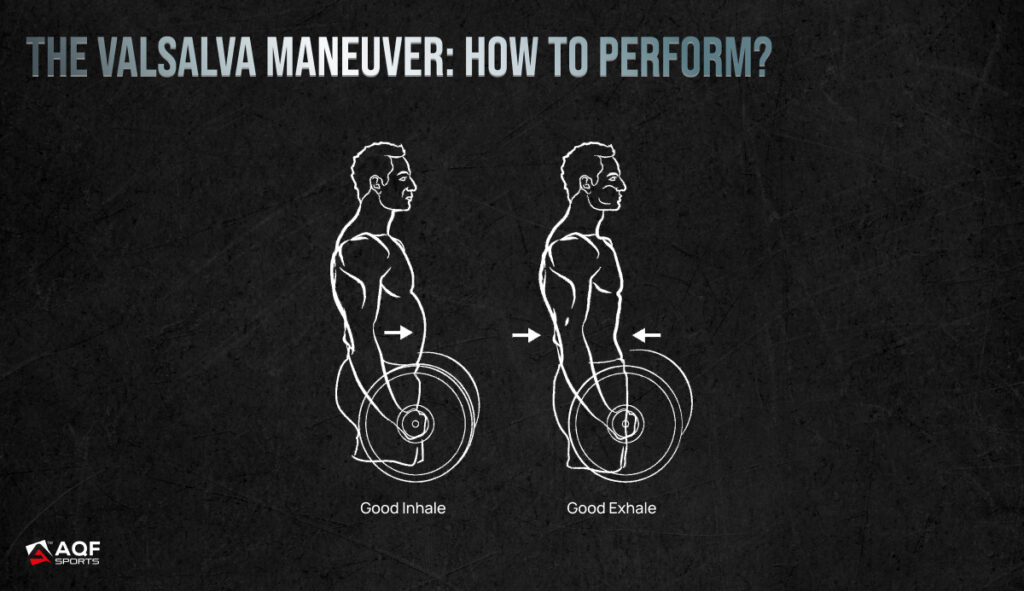
NOTE: Valsalva maneuver is an advanced technique and might not be suitable for everyone. If you have any medical conditions, especially hernias or heart issues, consult a healthcare professional before attempting this technique.
Use Weightlifting Belts
Weightlifting belts enhance lifting safety. Before strapping one on, learn the Valsalva maneuver. It’s essential to note that weight lifting belts might not be appropriate for certain hernias, such as inguinal hernias.
When is it appropriate to use a weightlifting belt?
Using a lifting belt is necessary if you are lifting around 70-75% of your maximum weight.
Place the belt just above your hip bones and secure it after inhaling deeply and expanding your abdominal area.

-
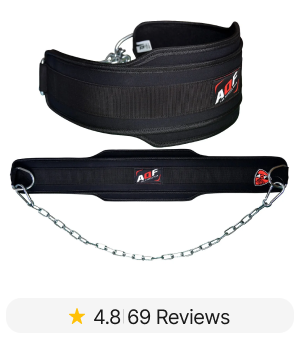
AQF Heavy Duty Dipping Belt with Metal Chain
£21.99
Buy Now -

AQF Lever Buckle Leather Powerlifting Belt 10mm
£34.99
Buy Now -

AQF Weight Lifting Nubuck Leather Power Belt
£22.99
Buy Now
Strength Building with Moderation:
You don’t have to lift extremely heavy weights all the time. This approach might not be suitable, especially if you’re new to lifting or concerned about hernias. Even experienced lifters incorporate variety.
What’s the strategy? Avoid excessive weights and techniques that strain your abdomen. Opt for challenging weights that don’t excessively stress your abdominal area. Striking a balance between strength training and hernia prevention is the key.
Additional Tips to Avoid Hernia in the Gym
Warm-Up Before Workout
Do light cardiovascular exercises and dynamic stretching before workout. This helps increase blood flow to your muscles and prepares your body for more intense activity.
Maintain Proper Form
Proper form is crucial to prevent excessive strain on your abdominal muscles and surrounding tissues. Whether you’re lifting weights or performing bodyweight exercises, ensure that you’re using correct technique to avoid unnecessary pressure on the abdominal area.
Follow Proper Breathing Technique
Never hold your breath while lifting weights. Exhale during the exertion phase of the lift and inhale during the relaxation phase. This helps regulate intra-abdominal pressure and reduces strain.
Engage Your Core
Engage your core muscles during lifts and exercises to provide additional support to your abdominal region. Imagine drawing your navel toward your spine to activate your core.
Avoid Rapid Increases in Weight
Gradually increase the weight and intensity of your workouts. Rapidly increasing the load can put undue stress on your muscles and increase the risk of injury.
Hydrate and Nourish
Proper hydration and nutrition are essential for muscle function and overall health. Dehydrated muscles are more prone to injury.
Listen to Your Body
Pay attention to any discomfort or pain while lifting. If you experience pain, especially around your abdominal area, stop the exercise immediately and assess the situation.
Rest and Recovery
Give your body adequate time to recover between workouts. Overtraining can lead to weakened muscles and increased susceptibility to injury.
The Bottomline
Hernias occur due to excessive pressure and strain in different parts of your body. If you notice a bulge or lump in your groin, abdomen, or any other part of your body, it might be a hernia. Hernia is a painful condition and you must avoid heavy lifting exercises. However, with proper precautions and care, you can avoid hernia.
Expand Your Understanding:






